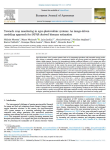Moretta M., Moriondo M., Leolini L., Padovan G., Staglianò N., Palchetti E., Lanini G.M., Bindi M., Rossi R. (2025). Towards crop monitoring in agro-photovoltaic systems: an image-driven modeling approach for fAPAR-derived biomass estimation. European Journal of Agronomy, 01/01/2025, vol. 170, p. 127748.
https://doi.org/10.1016/j.eja.2025.127748
https://doi.org/10.1016/j.eja.2025.127748
| Titre : | Towards crop monitoring in agro-photovoltaic systems: an image-driven modeling approach for fAPAR-derived biomass estimation (2025) |
| Auteurs : | M. Moretta ; M. Moriondo ; L. Leolini ; G. Padovan ; N. Staglianò ; E. Palchetti ; G.M. Lanini ; M. Bindi ; R. Rossi |
| Type de document : | Article |
| Dans : | European Journal of Agronomy (vol. 170, 2025) |
| Article en page(s) : | p. 127748 |
| Langues : | Anglais |
| Langues du résumé : | Anglais |
| Catégories : |
Catégories principales 16 - TRANSPORT. INFRASTRUCTURE. ENERGIE ; 16.3 - EnergieThésaurus IAMM ENERGIE RENOUVELABLE ; ENERGIE SOLAIRE ; EVALUATION DE L'IMPACT ; CROISSANCE ; RENDEMENT DES CULTURES ; PRODUCTIVITE ; AGRICULTURE ; MODELE |
| Mots-clés: | AGRIVOLTAISME |
| Résumé : | Agro-Photovoltaic (APV) systems optimize land use by integrating agriculture with renewable energy production, offering a sustainable solution to contemporary address the growing global food demand and mitigate climate change impacts. However, the heterogeneous shading conditions inherent to APV systems may affect crop growth and productivity, highlighting the need for innovative and accurate monitoring methods to ensure consistent production levels. In this context, the present study proposed and tested a hybrid approach that combines proximal sensing with a process-based crop model to estimate biomass accumulation within an APV system. Firstly, the performance of two-dimensional (2D) and three-dimensional (3D) imagery in capturing the phenotypic adaptations of alfalfa (Medicago sativa L.) over two consecutive growing seasons (i.e., 2023 and 2024) was assessed by empirically modeling fluctuations in the fraction of absorbed photosynthetically active radiation (fAPAR). Although the comparative analysis always revealed a strong correlation between observed and image-derived fAPAR values (R² = 0.74), the 2D-based models demonstrated higher accuracy than the 3D approach (RMSE = 0.07 vs 0.09, rRMSE = 10.83 % vs 17.16 %, AIC = −44.91 vs −56.27, respectively). Consequently, the daily fAPAR estimates derived from 2D data were used to force the SSM-iCrop2 model, providing accurate predictions of alfalfa biomass accumulation both in 2023 (R² = 0.96, RMSE = 36.26 g m⁻², rRMSE = 21.35 %, AIC = 151.37) and 2024 (R² = 0.88, RMSE = 46.98 g m⁻², rRMSE = 30.55 %, AIC = 129.07) when compared with field survey data. These findings demonstrate how the proposed image-driven modeling approach can be used as a potential tool for monitoring plant adaptation to varying shading conditions in APV systems. Moreover, its proven ability to predict crop yield with high spatio-temporal accuracy could inform mowing management strategies, optimizing production efficiency while aligning with sustainable agricultural and energy goals. |
| Cote : | En ligne |
| URL / DOI : | https://doi.org/10.1016/j.eja.2025.127748 |







